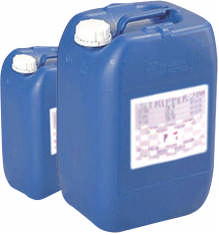MT-ATFC-103
(Polymer scale inhibitors and dispersants for membrane separation processes)
INTRODUCTION Membrane system demand high performance scale inhibitors to treat industrial water and allow the most efficient production of potable water from brackish water or sea water. MT-ATFC an efficient water treatment polymer is now available for preventing scale and deposits on membrane is separation application such as reverse osmosis (RO) and nano filtration. The feature and benefits of MT-ATFC is listed below:
FEATURES AND BENEFITS:
|
FEATURE |
BENEFIT |
|
MT-ATFC inhibits scale common to RO such as Calcium Carbonate and Calcium Sulfate with little or no acid control required. |
Inhibiting scale formation prolongs membrane life and lengthens the time between membrane cleanings. System efficiency is maximized by maintaining excellent permeate flow and % recovery. |
|
Products meet UL classification and European drinking water approvals. |
Polymer can treat portable water RO and thermal desalination systems. |
|
MT-ATFC contains preservative |
Preservatives prevents microbiological growth in storage tanks. |
|
MT-ATFC polymers is thermally and chemically stable |
Polymer is stable under all membrane water conditions and can be formulated with preservatives and other common water treatment chemicals |
TYPICAL SPECIFICATION:

TECHNOLOGY BACKGROUND:
Scale inhibition and deposit control are essential for maintaining efficient and cost effective operations such as RO systems. MT-ATFC is high performance scale inhibitor offered to the water treatment industry to maintain clean and longer lasting membranes in separation processes. Deposits on membranes can reduce permeate flow and increase pressure drop, greatly minimizing % recovery (yield) of the system. Hard scales can puncture membranes, allowing salt passage and microbiological contamination in the permeate. Also scale and deposits may cause channeling through membranes, thereby limiting flow to less scaled areas. Channeling reduces system efficiency and prevents effective cleaning of the scaled membranes.
RO (also called hyperfiltration) applies pressure to reverse the natural flow of pure water through a semipermeable membrane between solutions containing different salt concentrations. In order to generate pure water from salt water, the applied pressure must be greater than the difference in osmotic pressure between the two waters. RO removes all dissolved organic (non ionic) solids with molecular weight above 100 Daltons as a high percentage of ionic materials (typically 90 to 99%).
Nanofiltration is another membrane technology that has many of the same scale problems as RO. It is an intermediate process between RO and filtration, and has a molecular weight cut-off (MWCO) in the range between 400 to 800 Daltons. Ionic rejection varies depending upon the valence of the salts. Other membrane separation techniques include ultra-and microfiltration which filter colloids and suspended solids.
The amount and quality of the produced pure water(permeate) is frequently limited by the presence of scale forming salts in the raw feed water. These salts tend to precipitate as their concentration increases at the membrane surface during the separation process. If solubility limits are exceeded, scale forms and a cleaning cycle is required to restore membrane permeability and flux. Cleaning is costly in terms of time and chemicals.
Scale inhibitor such as MT-ATFC polymer increases the critical concentration above which crystallization occurs. Since scale can form from different salts (e.g. CaCO3, CaSO4, Silica and Iron), scale inhibitor must be carefully chose to match the scaling tendency of each specific water.
TYPICAL ADVANTAGE:
MT-ATFC have been specifically developed to target the scale common in effective on calcium carbonate, calcium sulfate, barium sulfate and other low solubility salts. This product complies with the requirements of UL classification for drinking water treatment additives in accordance with ANSI/NSF standard 60. MT-ATFC contains a preservative to prevent microbiological growth during storage..
The tables below compare the product efficiency of the MT-ATFC polymer with competitive products for inhibiting calcium carbonate and calcium sulfate. The higher the induction time, the better the scale inhibitor.
|
MT-DTFC-105 |
MT-DTFC-106 |
|
Descalant for RO Membranes: Acidic
COMPOSTION/INFORMATION ON INGRDIENT
Blend of Organic and Inorganic acids, emulsifier with and sequestering agents.
PHYSICAL AND CHEMICAL PROPERTIES
Appearance : Colorless to pale yellow liquid Form : Liquid. Specific Gravity : 1.10 + 0.05 pH(5%solution) : Less than 2 Boiling point : 100-1100C Water Solubility : Soluble in all Proportions Odour : Pungent |
Descalant for RO Membranes: Alkaline
COMPOSTION/INFORMATION ON INGRDIENT
Blend of Organic polymers, sequestering agent, emulsifier and alkaline cleaning agent.
PHYSICAL AND CHEMICAL PROPERTIES
Appearance : Colorless to pale yellow liquid Form : Liquid. pH(1%solution) : Alkaline Density gm/cc : 1.20 + 0.05 Water Solubility : Soluble moderately Odour : Pungent |